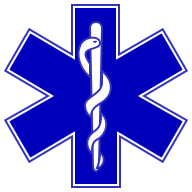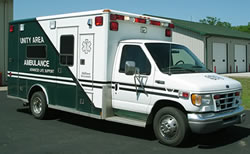Paramedic

A paramedic is a medical professional, usually a member of the emergency medical service, who responds to medical and trauma emergencies in the pre-hospital environment, provides emergency treatment and, when appropriate, transports a patient to definitive care, such as a hospital, for further assessment or follow-up care.
The use of the specific term paramedic varies by jurisdiction, and in some places is used to refer to any member of ambulance crew. In countries such as the United Kingdom, the use of the word paramedic is restricted by law, and the person claiming the title must have passed a specific set of examinations and clinical placements, and hold a valid registration with the governing body. Even in countries where the law restricts the title, popular media has created a culture where lay persons may refer to all emergency medical personnel as 'paramedics', even if they hold a lower qualification, such as emergency medical technician.[citation needed]
Places of work
Paramedics are employed by a variety of different agencies: by government (as part of a public hospital system, as a separate municipal EMS service, or sometimes, especially in the United States, as part of a fire department) or by private sector organizations (private hospitals, private ambulance companies). Paramedics may also work in other settings (e.g., emergency departments, hospital inpatient units, medical clinics, doctors' offices, oil rigs, steel mills, Air Ambulances and casinos).
Examples of skills performed by paramedics

Although there is a great deal of variation in what paramedics are trained and permitted to do from region to region, some skills performed by paramedics include:
- Basic Life Support/Advanced life support
- Advanced Cardiac Life Support - ACLS Such as:
- Manual defibrillation;
- Synchronized cardioversion;
- Transcutaneous pacing;
- Electrocardiogram monitoring and interpretation, including 12-lead ECG;
- Pediatric care, such as Pediatric Advanced Life Support (PALS) or Pediatric Education for Prehospital Professionals (PEPP);
- Trauma care, such as Prehospital Trauma Life Support (PHTLS) or Basic or Advanced Trauma Life Support (BTLS or ATLS)
- Basic and advanced airway management, including:
- Visualization the airway by use of the laryngoscope
- removal of foreign bodies with Magill forceps;
- Endotracheal and nasotracheal intubation, (including use of the Eschmann catheter);
- Esophageal intubation using an EOA (now discontinued) or a CombiTube
- Retrograde intubation;
- Rapid Sequence Intubation (RSI);
- Surgical cricothyroidotomy or needle cricothyrotomy/transtracheal jet insufflation;
- Continuous positive airway pressure (CPAP)
- Vascular access for medication administration and fluid resuscitation via several routes:
- Peripheral intravenous (IV) cannulation;
- Intraosseous (IO) cannulation (placement of needle into marrow space of a large bone), by hand, with a drill or spring-loaded device;
- Pulse oximetry and capnography;
- Needle thoracotomy for tension pneumothorax;
- Glucometry (testing blood sugar) for diabetic patients
- Venous blood samples
- Ventilator and IV pump management
- Administration of medications via intramuscular, subcutaneous, intravenous, sublingual, endotracheal, rectal, oral, intranasal, intraosseous and buccal routes
Paramedics in some places administer a variety of emergency medications; the individual medications vary widely based on medical director preference, local standard of care, and law. These drugs range from calcium channel blockers that slow the heart rate to sympathomimetics like dopamine for severe hypotension (low blood pressure). Medications for treating respiratory conditions such as albuterol are common. They may also administer elective medications such as those which relieve pain or decrease nausea and vomiting. Nitroglycerin, aspirin, and morphine may be administered for chest pain. Other medications are used to treat cardiac conditions such as a myocardial infarction and various dysrhythmias.
In other places, the term paramedic is used to describe anyone who has a role in emergency medical care, and may not indicate a level of training or the ability to perform medical procedures at all.
Different qualification levels across the world
In the US, there are 4 levels of prehospital care defined by the US Department of Transportation (which regulates prehospital education). In order of level of training, they are First Responder, Emergency Medical Technician-Basic (EMT-B), Emergency Medical Technician-Intermediate (EMT-I), and Emergency Medical Technician-Paramedic (EMT-P). Some systems within the US refer to both EMT-Ps and EMT-Is as "paramedics". In Canada there are 3 levels of Paramedics, with the Primary Care Paramedic equivalent to an EMT-B, the Advanced Care Paramedic equivalent to the standard paramedic, and the Critical Care Paramedic employed in the flight paramedic role (except in Alberta which uses the terms EMT and EMT-Paramedic).
In many parts of Europe and some cities in Canada, a different paradigm is used for prehospital care in which doctors, nurses and occasionally medical students function as prehospital providers, either in conjunction with or instead of paramedics. Other parts of the world, such as Hong Kong, are currently progressing toward a system staffed with paramedics. [1].
Paramedics may function under the authority and indirect supervision of a physician (as is the case in the United States), both through standing protocols (off-line medical control) or through direct physician consultation via phone or radio (on-line medical control), or, as is the case in the United Kingdom, they may be autonomous practitioners, with their own clincial judgement, ability to diagnose and prescribe.
In the media
The 1970s television show Emergency! was a very popular series which centered on the work of paramedics in the Los Angeles County Fire Department, and the staff at the fictional Rampart Emergency Hospital. Emergency! has been widely credited with inspiring many municipalities to develop their own paramedic programs, and has inspired many to enter the fields of emergency medicine. The show was a top rated program for its entire production run (1972 - 1979), as well as in syndicated television reruns -- even inspiring a Saturday morning cartoon series.
Paramedics is also the name of a show on the Discovery Health Channel, which details the life and work of emergency medical squads across the country. It is also the name of a 1988 Comedy which highlighted the lighter side of EMS.
Paramedic: On the Front Lines of Medicine (1998), by Peter Canning, is an autobiographical account of a paramedic's first year on the job. Rescue 471: A Paramedic's Stories (2000) is the sequel.
Bringing Out the Dead (1999), directed by Martin Scorsese and starring Nicholas Cage is one of very few films about paramedics. The main character is paramedic Frank Pierce who works in New York's Hell's Kitchen. He's become burned out and haunted by visions of the people he's failed to save including a little girl.
Into the Breach: A Year of Life and Death with EMS (2002) Book written by J.A. Karam is the true story of paramedics, emergency medical technicians, and heavy-rescue specialists fighting to control trauma and medical emergencies. Into the Breach offers an unusual opportunity to bear witness to unimaginable suffering, heroic stoicism, and the inventiveness of American EMS workers fighting to save lives.
Parts of Third Watch (1999) were devoted to adventures of the fictional 55th precinct FDNY EMS unit, created by ER executive producer John Wells.
Saved (2006), a TNT series centered on paramedic Wyatt Cole (Tom Everett Scott), his partner, and their chaotic lives on and off the job.
See also
- Paramedics in Canada
- Paramedics in France
- Paramedics in Germany
- Paramedics in the United States of America
- Paramedics in the United Kingdom
- Paramedics in Australia
- Paramedics in Turkey
- National Association of Emergency Medical Technicians
- NREMT
- Flight Paramedic
- Emergency Medical Care
References
- American Heart Association (Jan. 2006)
- Meisel, Zachary (2005-11-08). "Ding-a-Ling-a-Ling— Ambulances can be dangerous places". Slate. Washington Post.Newsweek Interactive Co. LLC. Retrieved 2007-01-25. Check date values in:
|date=(help) - "Tribute to R Adams Cowley, M.D." University of Maryland Medical Center. Retrieved 2005-12-30.
- US DOT "National Scope of Practice Model" (PDF). National Highway Traffic Safety Administration. Retrieved 2007-04-16.
External links
da:Paramediciner de:Rettungsassistent he:פאראמדיק no:Ambulansearbeider tk:Paramedikleri Template:Jb1